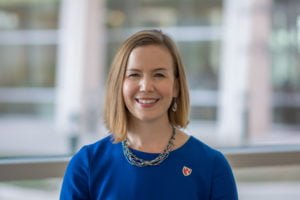It Takes a Village: Bridges and Barriers in Collaborative Population Health Interventions
LaShaune JohnsonMelissa Tibbits is an associate professor at the University of Nebraska Medical Center in the College of Public Health. She was trained in human development and family studies with a focus on promoting adolescent health. Within public health, she primarily works in the subfield of maternal and child health. In January 2017, she received the University of Nebraska Medical Center’s Distinguished Scientist Award. Recently, I talked with her about her unique path to population health and how she addresses issues that arise in collaborative pop health work.
Can you tell me more about your training?
In graduate school at Penn State, I focused on the implementation, evaluation, and dissemination of evidence-based interventions to promote adolescent health. In my current role, I mainly focus on the evaluation of community-wide, multi-component, multi-sector adolescent health initiatives. This shift was due to my increased understanding of population health models such as Frieden’s health impact pyramid, and my growing interest in affecting systems change.
Would you like to discuss one of the larger projects you are currently working on? 
Right now I am evaluating the Adolescent Health Project developed by the Women’s Fund of Omaha. It is focused on preventing STDs and teen pregnancy among 15-24 year olds. The Adolescent Health Project includes media campaigns, free STD tests and treatment, free contraception, free condoms, and advocacy for comprehensive sex education within local schools. To make this happen, there are several clinical partners who collaborate with the Women’s Fund of Omaha, along with countless community partners.
So, who makes decisions about interventions and goals?
There were many people in Omaha working on sexual and reproductive health, but there wasn’t a clear collaborative before The Women’s Fund took a two-pronged approach. They tried to, early on, engage who they thought would be the key players, but they also took a lot of initiative in determining interventions and setting goals. In other collaboratives I’ve seen that are even more established, like obesity initiatives in Omaha, I see more bottom-up decision-making. And I don’t know if there’s a right or wrong. I think it just is context-dependent. And if there hasn’t been much collaboration to start, you might at least initially need some top-down goals. And then maybe it can move to more of a bottom-up approach.
Do you have any recommendations for researchers and folks who want to work with identified populations, service providers, and partner groups? How can these groups secure a seat at the table?
There has to be intentionality, and that’s a big drawback of many population-level health initiatives, even ones that are fantastic in every other way. It’s easier to work with people who are similar to you. It’s harder to engage with people who haven’t been at the table or are hard to find, or are just different from you. I don’t think there always has been that intentionality in projects, in general, to be inclusive. It might help to perhaps incentivize participation of diverse partners, or at least make sure that all groups are receiving equitable compensation (e.g., grant funds), decision-making (e.g., goal setting), and respect for their time (e.g., a role in determining meeting schedules). Additionally, if you have eight men and one woman, is that a balanced enough representation? Or if you have one African-American person and ten white people at the table, is that enough, and how do you make decisions about how to adequately represent stakeholders? This is something we need to work through if our interventions and solutions are really going to have population-level effects. It’s always a question of knowing who essential to a successful collaboration and solution, as well as getting groups engaged equitably
Were there ever any unanticipated challenges in doing this work?
Yeah. I think a big challenge across the board, probably for any project, is sufficient funding. Probably for this reason, initiatives I’ve seen that have been very collaborative, multi-level, population health-focused were centered around a grant. And when the grant was over, to some degree, at least some of that work ended, or the collaboration ended. Another challenge, as we’ve already discussed a bit, is making sure that you’re pursuing the right initiatives and engaging the right people to help you do that equitably and successfully. As public health professionals, we’ve been critiqued for speaking for people rather than legitimately bringing them to the table. We need to work toward engaging people who need to be involved, and do it in an authentic way.
Since youth is your focus, are there things that you do differently or you would encourage people to consider for a youth-focused project, like the Adolescent Health Project?
The main thing is that I’ve realized is that even though I am a relatively young public health professional, I’m not 15 anymore, and times have changed. Technology has changed, sexual attitudes have changed, lots of things have changed. It is important to be mindful that even though you think you understand a particular group—in this case, youth—you may not. You need to get their perspective in an authentic way in order to design initiatives for them, and in some sense, with them. And it’s not a one-time thing. No matter what methods you use, check back with your focal population and make sure that what you’re doing is resonating, whether it be with youth or people of color or the elderly.
Are there any principal theories or readings that you would suggest to communities or researchers who are considering this sort of broad multi-level approach to population health interventions?
Collective Impact from FSG is a good model: a key feature is a backbone organization. If there’s nobody to do the basic infrastructure work, such as scheduling meetings, preparing materials, making sure everyone is on the same page, it is really easy for things to fall off track. And I really like the shared goals and measurement features of the Collective Impact model.
The Robert Wood Johnson Foundation does a lot of work around systems change and a community of health model. Their publications and the projects they fund would be good resources for thinking about how to affect a system and how to affect a whole community, rather than traditional individual-level interventions in isolation.
 Melissa Tibbits, PhD, is an associate professor at the University of Nebraska Medical Center in the Health Promotion department. She focuses her research and teaching on the development, implementation, and evaluation of population health interventions that promote healthy adolescent development and prevent outcomes such as sexually transmitted infections and teen pregnancy.
Melissa Tibbits, PhD, is an associate professor at the University of Nebraska Medical Center in the Health Promotion department. She focuses her research and teaching on the development, implementation, and evaluation of population health interventions that promote healthy adolescent development and prevent outcomes such as sexually transmitted infections and teen pregnancy.
For more information about the Adolescent Health Project: http://www.omahawomensfund.org/leading-change/adolescent-health-project/





All comments will be reviewed and posted if substantive and of general interest to IAPHS readers.